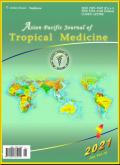皮肤炭疽伴面瘫1例
IF 1.6
4区 医学
Q3 PUBLIC, ENVIRONMENTAL & OCCUPATIONAL HEALTH
引用次数: 0
摘要
理由:炭疽病是一种由革兰氏阳性炭疽杆菌孢子引起的人畜共患疾病,通常影响哺乳动物,在极少数情况下影响鸟类。人类感染是通过直接或间接接触动物或其产品而意外发生的。患者关注:一名63岁的男子因流感样症状被转诊至我们医院,面部、口腔顶部和鼻孔严重肿胀和发红。两天前,他曾与一只屠宰过的羊肉有过直接接触史。他宣布糖尿病、高血压、高甘油三酯血症和心力衰竭得到控制。肺部高分辨率CT显示肺部正常,但纵隔内可见多发淋巴结病变。双侧腋窝淋巴结肿大,最大sad为23mm,右侧胸腔积液。鼻腔和鼻窦的CT扫描显示左上颌窦息肉密度增加。从患者的病变处制备载玻片,并在光学显微镜下进行检查。可见芽孢杆菌和链球菌。诊断:炭疽合并疱疹系统性病毒和化脓性链球菌感染。干预措施:从适当的抗生素开始进行多种药物治疗。结果:患者的症状逐渐消失。病人出院后没有任何并发症。经验教训:在流行地区,有皮肤表现和接触过受感染动物或产品史的患者的皮肤炭疽病应被视为鉴别诊断。这在混合感染中更为重要,因为混合感染可能隐藏了问题的主要原因。本文章由计算机程序翻译,如有差异,请以英文原文为准。
Cutaneous anthrax associated with facial palsy: A case report
Rationale: Anthrax is a zoonotic disease caused by spores of Gram-positive Bacillus anthracis, commonly affects mammals and in rare cases birds. Human infection occurs accidentally through direct or indirect exposure to animal or their products. Patient concerns: A 63-year-old man was referred to our hospital with flu-like symptoms and severe swelling and redness on the face, the roof of the mouth, and nostrils. He had a history of direct contact with a slaughtered mutton two days ago. He declared controlled diabetes, hypertension, hypertriglyceridemia, and heart failure. Lungs were normal in lung high resolution CT, but multiple lymphadenopathies were seen in the mediastinum. Bilateral axillary lymphadenopathy with a maximum sad of 23 mm and pleural effusion on the right side was observed. CT scan of the nose and sinuses showed an increased density of polyps in the left maxillary sinus. Slides were prepared from the patient's lesions and examined under a light microscope. Bacillus shape with Streptococcus bacteria was seen. Diagnosis: Anthrax co-infection with herpes systemic virus and Streptococcus pyogenes. Interventions: Multidrug therapy started with appropriate antibiotics. Outcomes: The symptoms of the patient gradually disappeared. The patient was discharged without any complications. Lessons: Cutaneous anthrax in endemic areas in patients with skin presentations and a history of contact with infected animals or products should be considered a differential diagnosis. This is more important in mixed infections where the main cause of the problem may be hidden.
求助全文
通过发布文献求助,成功后即可免费获取论文全文。
去求助
来源期刊

Asian Pacific journal of tropical medicine
PUBLIC, ENVIRONMENTAL & OCCUPATIONAL HEALTH-TROPICAL MEDICINE
CiteScore
4.00
自引率
9.70%
发文量
1936
审稿时长
3-8 weeks
期刊介绍:
Asian Pacific Journal of Tropical Medicine (ISSN 1995-7645 CODEN: APJTB6), a publication of Editorial office of Hainan Medical University,is a peer-reviewed print + online Monthly journal. The journal''s full text is available online at http://www.apjtm.org/. The journal allows free access (Open Access) to its contents and permits authors to self-archive final accepted version of the articles on any OAI-compliant institutional / subject-based repository.
APJTM aims to provide an academic communicating platform for international physicians, medical scientists, allied health scientists and public health workers, especially those of the Asia-Pacific region and worldwide on tropical medicine, infectious diseases and public health, and to meet the growing challenges of understanding, preventing and controlling the dramatic global emergence and re-emergence of infectious diseases in the Asia-Pacific.
The journal is proud to have an international and diverse editorial board that will assist and facilitate the publication of articles that reflect a global view on tropical medicine, infectious diseases and public health, as well as emphasizing our focus on supporting the needs of public health practitioners. The APJTM will allow us to seek opportunities to work with others who share our aim, and to enhance our work through partnership, and to uphold the standards of our profession and contribute to its advancement.
 求助内容:
求助内容: 应助结果提醒方式:
应助结果提醒方式:


